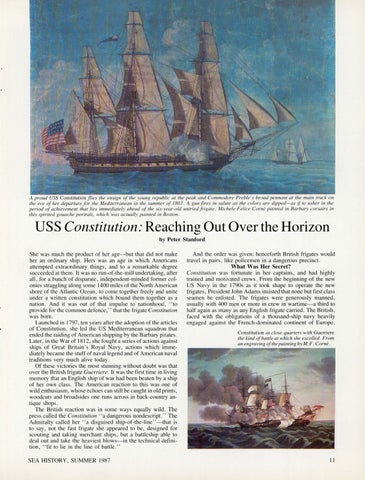A proud USS Constituti on f lies the ensign of the young republic at the peak and Commodore Preble' s broad pennant at the main truck on the eve of her departure f or the Mediterranean in the summer of I 803. A gun fi res in salute as the colors are dipped- as if to usher in the period of achievement that lies immediately ahead of the six-year-old untried fr igate . Michele Felice Corne painted in Barbary corsairs in this spirited gouache portrait, which was actually painted in Boston.
USS Constitution: Reaching Out Over the Horizon by Peter Stanford
She was much the product of her age-but that did not make her an ordinary ship . Hers was an age in which Americans attempted extraordinary things , and to a remarkable degree succeeded at them . It was no run-of-the-mill undertaking, after all , for a bunch of disparate , independent-minded former colonies straggling along some 1400 miles of the North American shore of the Atlantic Ocean, to come together freely and unite under a written constitution which bound them together as a nation. And it was out of that impulse to nationhood , " to provide for the common defence, '' that the fr igate Constitution was born . Launched in 1797 , ten years after the adoption of the articles of Constitution, she led the US Mediterranean squadron that ended the raiding of American shipping by the Barbary pirates . Later, in the War of 18 12 , she fo ught a series of actions against ships of Great Britain ' s Royal Navy , actions which immediately became the stuff of naval legend and of American naval traditions very much ali ve today . Of these victories the most stunning without doubt was that over the British fri gate G uerriere . It was the first time in living memory that an Engli sh ship of war had been beaten by a ship of her own cl ass . The American reaction to thi s was one of wild enthusias m, whose echoes can still be caught in old prints, woodcuts and broadsides one runs across in back-country antique shops. The British reaction was in some ways equally wild . The press called the Constitution " a dangerous nondescript. " The Admiralty called her " a di sgui sed ship-of-th e-line"- that is to say, not the fas t fri gate she appeared to be, designed for scouting and taking merchant ships, but a battleship able to deal out and take the heaviest blows- in the technical definition, " fit to lie in the line of battle." SEA HISTORY, SUMMER 1987
And the order was given: henceforth British fri gates would travel in pairs, like policemen in a dangerous precinct.
¡What Was Her Secret? Constitution was fortunate in her captains, and had highl y trained and motivated crews. From the beginning of the new US Navy in the 1790s as it took shape to operate the new frigates, President John Adams insisted that none but first class seamen be enlisted . The frigates were generously manned , usually with 400 men or more in crew in wartime-a third to half aga in as many as any English frigate carried . The British, faced with the obligations of a thousand-ship navy heav ily engaged against the French-dominated continent of Europe , Constitution at close quarters with G uerriere the kind of battle at which she excelled . From
an engraving of the painting by M.F. Corne .
11
